33 Finding Waters: Spirit of Fly Fishing
Trevor Stotlar
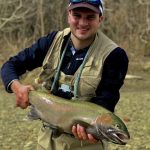
Hi, my name is Trevor! What inspired me to write this paper is my passion for the outdoors, especially fly fishing. Being an avid fly fisherman for over 12 years, I have learned more about this art and what it truly means to me. To me, fly fishing is more than just a hobby, it is a connection between myself and the natural world that is often looked over. It has inspired me through the years to be an active environmentalist which still inspires me to this day. I find that fly fishing has a direct correlation with spirituality in which we find that connection between ourselves and the natural world…read more.
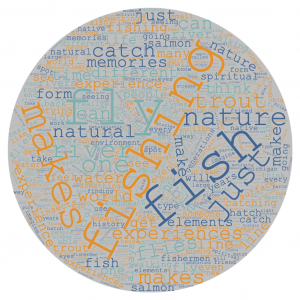
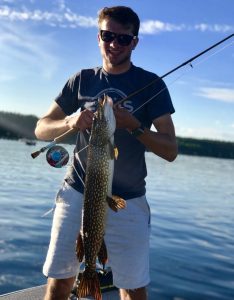
One of my greatest memories is from a trip up to the northern region of Michigan. It was mid-October and in the prime of fall. The leaves were fluorescent oranges, yellows, and browns. Water clearer than the Bahamas. There were king salmon free-swimming up and down taunting me to throw a fly at one. But I just had to sit back and embrace this moment of true peace between the fish and their home habitat. I just could not throw a line in without admiring the beauty that was painted on a natural canvas in front of my own eyes. These are moments that stay with you and make you rethink your place on this Earth. Fly fishing has given me many different moments just like this one. Fly fishing is not just a hobby for me, but it is an escape from the concrete jungle of everyday life. When you fly fish, it gives you a form of peace within your life and a sense of spiritual solitude that stays with you. Sometimes, the beauty of nature simply awes us, and lifts us up; at the same time, there is a lot of history and technique that make fly fishing such a worthwhile pursuit.
Fly fishing is an outdoor art form that has been around for thousands of years, and a whole set of specialized equipment has evolved with the sport. It is mostly known for river and stream trout fishing for a variety of fish species. There are many different stream types that can be fly fished. From high up freestone mountain streams for brook trout, all the way to large flowing rivers for migratory salmon. Fly fishing equipment includes an 8-13 foot rod to make the perfect and smooth swings to get that fly where it needs to go. It also includes the use of a round single action reel that has backing (heavy-duty fishing line) that is then connected to a fly line. [1] Unlike traditional methods of fishing, instead of using heavy fishing lures to help cast your light fishing line out, you are using a weighted fly line. Each casting motion from front to back lets out more line to allow the nearly weightless fly to reach its target. [2]
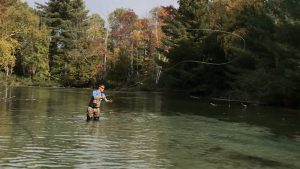
The “lures” used for fly fishing are actually called flies. These fuzzy-looking artificial lure-like creations of mimicry are what is so natural and pure about this form of fishing. Flies can represent a small nymph in a freestone stream, up to a mullet in the Gulf of Mexico. Most of these flies weigh less than a paperclip which requires them to be swung out over the water’s surface by the weighted fly line. Different types of fly rods determine what flies can be cast by them. While it seems that there is a lot of work that goes into fly fishing, piecing together all the parts make it so much more naturalistic than traditional style fishing.
People underestimate how enjoyable fly fishing actually is. Just by looking at it, you think to yourself “why would anyone possibly fly fish?” You wake up at the crack of dawn, put on a type of “wetsuit”, stand out in the middle of the river, and try to use some complicated fishing tool to catch fish that might be the size of your hand. You might think this is crazy, but this is not just a sport, it is an art form that takes skill and patience that enhances your thinking ability. There are many elements that come into play that make you more integrated into the sport. Fly fishing makes you think more critically about what you are doing. Starting with the flies that you use; you have to know the body of water that you are fishing. For example, fishing in a high mountain free-stone stream requires you to match the hatch. This means lifting rocks and sifting through the dirt from overturned rocks to see what kind of insects are hatching. If you want to match the hatch then you have to find out what the trout are feeding on for that particular day. You can also use visuals such as spider webs, flying insects, etc. to imagine a trout coming up to feed upon one on the surface of the water. Once you find out what type of insects are hatching for that day, then you open your perfectly organized fly box with over twenty different fly patterns that imitate all sorts of different insects.
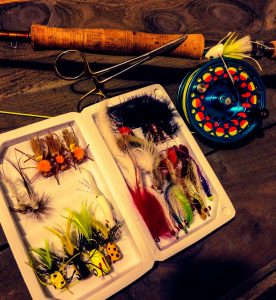
There are two types of fly fishermen, those who tie their own flies, and those who purchase their flies. Those who tie their own flies take on part of the artistic aspect of fly fishing. They use all sorts of different hackles, deer hair, feathers, threads, different sized hooks, and more. These materials are used to make a simple hook into something that looks like a realistic fly pattern. Fly tying brings you closer to the fish by being able to mimic their next meal. It is the fundamental aspect of the naturalistic appeal of fly fishing.
Fly fishing first originated in Europe. Europeans considered fly fishing a more naturalistic and simplistic method of fishing, mainly to catch trout. In Europe, there are high abundances of rainbow trout and brown trout. Most Europeans target these species with just simple fly rods and hand-tied flies. Back in the colonial days of America, Europeans introduced a lot of non-native species to America which included cutthroat, rainbow, and brown trout. Most of these trout were introduced in the Western portion of the country due to the large mountain ranges, free-flowing streams, and the low water temperatures that can support these trout. This is one of the explanations as to why the west is one of the larger fly-fishing regions for trout.
Some of the original forms of fly fishing go back even further in history. The first written records of fly fishing are found in the book On the Nature of Animals by the Greek writer, Claudius Aelianus, in 200 AD. He talked about artificial flies used in rivers to catch trout (Lovelock, 2007). By the time of early American settlement by Europeans, in addition to providing fish for the table, fly fishing had established itself as a form of relaxation. In Nature/Culture and Fly Fishing in the New West, Jeffrey Hostetler explained that “the established classes of humanity throughout history have always found time and places to relax and depart from the day’s toils” (Hostetler, 2006, p. 42) [3] Fly fishing was not just an activity or hobby, it was an escape from everyday life. The settlers used it for just that: as a type of stress reliever. It was also a means of getting and providing food. Europeans developed sleek versatile fishing rods to fish small and large rivers. The overall natural look of the fly and the natural feel of the fly rod in your hands make it an easier way to catch fish. This is one of the reasons why many people sought out fly fishing as their main method of choice.
The same styles and nature of fly fishing have stayed consistent over the years. The ecology, the presentation, and the liberation that fly fishing grants you; never change. The way you present that fly manipulates nature for a small ounce of joy and gratitude of catching that one fish. You have to be able to read the river, know how to land a fish, and how to be aware of your surroundings. Fly fishing brings out our natural selflessness. It focuses on what can be observed on the river that makes us pure. You cannot just take a fly rod and pretend you know what you are doing and catch a fish. The elements that make this sport so liberating are the challenges that come with it. Being able to read the river, cast that fly in the right spot, matching the hatch, and or tying that fly are the challenging parts of fly fishing. Izaak Walton once said, “Angling may be said to be so like the mathematics that it can never be fully learned” (Walton, 1653). There constantly are things to improve upon with fly fishing even if you consider yourself a master. We like to be challenged as people, we live by it. Fly fishing evolves around this concept. There is always going to be frustration. Frustration is what makes you work at it, and drives you to overcome and master this form of fishing.
I find that fly fishing is healthy for my soul. Every time I go out on the river, I can feel the fresh air and light mist from the river on my face. These types of experiences liberate the soul. Being able to not only fish but to venture out to the unknown parts of nature. To hike for miles and miles to get to that one spot that you have been thinking about all week while at work. It makes you think less about your everyday stresses of the modern world. Once you get to “that spot,” it will seem that every worry, stress, and anxiety will all float down the river behind your wake. Walking through a highly dense vegetation forest in a surreal environment untouched by the urban jungle. Finding a spot on a meandering never-ending cold-water stream to scout out cold-blooded living pieces of art. This is what makes you focus on only one goal. The goal of seeking out adventure and fish. Being able to focus on that goal makes you a clear thinker. Being able to focus your mind on finding the fish and preparing your presentation helps refresh your mind to have a clearer consciousness. In the end, it makes you more of a visionary and makes you a clearer thinker when you return back to the modern world. From my personal experiences from over my 9 years of fly fishing, I can say I am a clearer thinker because of my experiences on the river. From adventure to new experiences, this is the key to making my mind whole. It is finding myself within the natural world around me that creates a divine experience.
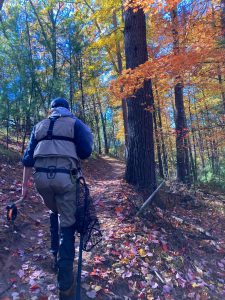
Fly fishing humbles me because it makes me feel small. Seeing how truly large the natural world is around me while walking down the river, makes me think differently about where we stand in the world. I see that people are not the dominant being on this planet, there is a whole other world that we share. Fly fishing makes me see this other world that you never would have thought existed unless you adventure out of your elements. Fly fishing is what brings me out to this other divine world of God’s creation. It makes you realize that you are not in control. Whether that is the fish that took you for a ride downriver or the elements of weather patterns that change the landscape of the river or of your surroundings. Knowing that you are not in control immerses you deeper into the realism of the spiritual experience that comes with fly fishing. It makes you think if you have actually lived or if you truly have not lived.
Fly fishing provides a range of spiritual elements. Elements not just from fishing, but from the elements of the experience that make us have these spiritual experiences. When I am on the river, I just think about how beautiful our world truly is and how it is taken for granted. The river flows through our soul and cleanses it. When you are able to see the natural world before your eyes, it changes you. It makes you view nature as one of us such as when you catch a fish. It is easy to think that the fish are just food for us, but being able to release the fish gives you a whole different feeling. Knowing that that fish will live on and grow even larger for other people to have the chance to catch that fish for generations makes releasing the fish such an unreal experience. The practice of catch and release is very common in fly fishing. The spiritual experience between man and fish makes you appreciate the fish a lot more. Everyone has their own different experiences, but in the end, it is all about the spirit of the experience and something much greater than us.
I like these elements because they are considered to me as elements of natural immersive spirituality. I have been to a lot of rivers in the years that I have been fly fishing, and they all have interesting names. Many got their names from the Native Americans who lived in these areas before me. Being in these places evokes myths and stories of the indigenous tribes who called these places home. As LaPiar, a professor from The University of Montana stated, “Native Americans view nature through their belief systems. A river or water does not only sustain life-it is sacred” (LaPier, 2017). Native Americans relied on these rivers and claimed them to be sacred in their own minds. The flow of the water was more than just water moving, it is a story that flows down the rivers.
Walking down through a sacred river is walking through the eyes of history. Being able to really study the insects, the fish, and the water itself takes you back to a different time. Fishing in the same river that Native Americans have fished for generations inspires fly fishermen to protect and respect that river and the land that surrounds it. I have firsthand fly-fishing experience with walking through history. There is a very small town called Telluride deep in the San Juan mountain range on the southwestern edge of Colorado. Telluride is an old mining town with a river running through it. The town has stories from generations from the old mining community about spirits and spiritual experiences in the valley and of the river itself. When I was fly fishing there, I felt that I was in a different time period where things were simplistic and thought about how they used the river as a food source. These types of experiences seem rare in modern life. Fly fishing truly immerses you not only physically, but mentally.
Fly fishermen also get immersed in the art of tying flies. I have personal experience with this. I have been fly tying for the past four years of my life and it is an experience that is hard to express. Watching a wild Brook trout surfacing to eat a fly that you created from nothing but hard work and dedication makes it worth it. The calming feeling of something special coming out of something you created makes you think about nature from a different perspective. The feeling of tying on that right fly to match the hatch and catching a fish on it is just surreal. [4] Finding what the hatch is brings you closer to nature than you would have ever thought. In order to find out the different hatches for that particular day, you have to study the environment around the river. When doing this you have to ask yourself questions such as: Are the trout rising for surface flies? Are there swarms or insects? And/or are there nymphs under rocks? All of these are questions that can be asked when trying to find the hatch. This opens your eyes to not only the fish but the intricately diverse ecosystem and the ecology between these different organisms. Not everyone is able to have this connection between man and nature up this close. Some might say that fly fishing is a way of studying the river and the natural environment religiously.
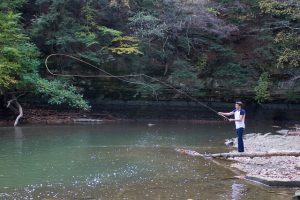
Imagine walking down the river and seeing native trout eating flies off the surface of the river. Then you take your fly box out and look at the flies that you have spent countless hours tying. Pick out the right fly for that hatch and tie it on the end of your fly line. You are about to set the stage for what you may call the natural presentation of a fly on the river’s surface. Imagine watching a trout sucking up the fly that you tricked it into thinking it was another lonely fly on the river’s surface. The accomplishment of catching that fish on a fly you tied makes the experience unforgettable. It is not just about catching fish, it is the entire process and experience that led you to catch that fish.
These experiences and memories go hand and hand with each other. Experiences make the memories and the memories tell the stories. Fly fishing is where memories begin in a fisherman’s life. When driving to your favorite spots you would think it would get boring seeing the same landscape each time, but this is not the case. The environment is constantly changing in different areas, whether that is a tree that fell in the river, new wildlife that you had never seen before, or even a different water flow. These are all different factors that make a fishing spot different every time. Whenever I go out on the river, I see new things. Every time this happens, I form different memories. It makes you exude your love towards the world and the environment when it is seen through different experiences. You always hear people say how their calling is in nature. Fly fishermen say the same thing about the river. This type of experience is not always solo but often is with the person that you fish with the most.
A lot of fly fishermen have at least one close friend who they can call a good fishing friend. Sharing this type of experience on the river not only enlightens you, but it makes great memories with a lifetime friend. In the journal New Streams of Religion: Fly Fishing as a Lived, Religion of Nature, Snyder quoted Benjamin Casarez who said, “‘Even when fishing twenty feet from your best buddy, the experience of fishing, catching and landing fish is always individual.’ Casarez continued after a pause, ‘However, knowing and seeing your fishing buddy there certainly adds to the entire experience, without him or her there, it would not be quite the same’” (Snyder, 2005, p. 900). Having that close friend and sharing that type of experience with him makes the experience a lot better because you have someone to share it with. Friends or family members that you may take to the river do not have to be avid fly fishermen at all to enjoy what nature has to offer. Being able to teach someone how to fly fish and then see them succeed because of your teachings makes you feel good inside. It makes you realize that watching someone else enjoy a cherished tradition that has been part of your life for years is a much more valuable experience. Going by yourself and catching that dream fish, or having such a surreal moment in nature is not the same when you are by yourself. Having someone feel that same connection, that same bend of the rod when hooking into a fish is what makes this form of fishing so spiritual. Teaching this art form through generations, passing on these traditions and rituals, has made this activity a sacred form of fishing.
The sacrality of fly fishing has been protected throughout many generations. Fly fishing has deeply impacted many people’s lives. This could be by observing someone, getting taught by someone, or just by fly fishing for many years. All these experiences are different in their own ways, but they all create the same experience of being out in nature. Fly fishing has shown time and time again that it can change people through their viewpoints, who they are, personality, and beliefs. It is not just an outdoor activity, it is influential. It influences people to help protect the natural scenic rivers that are the life support of these pristine landscapes. It gives them memories to cherish throughout their lifetime.
Imagine being in the middle of a frigid river in the heart of fall in the great state of Michigan. This is one of the most cherished fishing memories I have experienced. We were targeting king salmon, also known as chinook salmon. These fish are not just big fish moving upriver, they are the powerhouses of the river. I found this out very quickly on this trip. After hiking over several miles up a river surrounded by untouched nature, we finally saw a salmon. I know this was a sign that my dedication to trying to catch one of these magnificent species was going to pay off. After two drifts of my fly past this fish, I finally feel my line tighten. I set the hook. For ten minutes the fish did not realize that it had just eaten my fly. The moment it did realize that it was hooked, I would be on the fight of my life. It is very easy to underestimate nature. It is a powerful salmon that can take you for a ride and this fish showed me that first hand. Running down the river not knowing when this fish was going to stop. Sweat dripping down my face, anxiety kicks in, and nervousness starts to overwhelm me. After the first one hundred yards of pure intensity, I see this fish jump. I realized at that moment that I did not just have a fish on, but I had the largest salmon I have ever seen at the end of my fly. Terrified of losing the fish, I panic and try to get the fish in quickly. This led to the fish taking me for a ride under a fallen tree in the river. After managing to get my rod under the tree, a miracle happened, I still had that fish on my line. To my excitement, the fish made another long run about another one hundred yards downriver. At this moment I knew what was going to happen, and it did happen. My hopes and dreams just went swimming down the river with the fish as I see my fly come straight out of the water. I thought I was going to be truly upset with this fact, but I was the complete opposite. I realized why I enjoy fly fishing so much. It is not the catch that makes fly fishing enjoyable, but it is the memorable experiences that you get from it. After seeing that fish get away, it makes me respect it even more for the true power that nature brings to the table. The fish will never stay with you forever, but the memories will, and that is something you cannot take for granted. Though the big one always tends to get away, I still managed to catch a good-sized salmon a couple of weeks later.
The big one is still out there, but catching any big fish makes you realize just how amazing these fish truly are. There will always be defeat, but in the end, you will have a smile on your face even if you catch or do not catch a fish. I am looking forward to my next adventure on the river for many more memories to come.
References
Crowder, R. (2002). Check Your Fly. Canadian Women Studies, 21(3), 162-165.
Fife, W. (2017). Fly Fishing as Religion: Literature as a Form of Public Anthropology of Consciousness, 28(1), 7–30. doi:10.1111/anoc.12064
Genova, P. (1998). First cast: teaching kids to fly-fish. Mechanicsburg, PA: Stackpole Books
Hostetler, J. W. (n.d.). NATURE/CULTURE AND FLY FISHING IN THE NEW WEST by Jeffrey … Retrieved from https://scholarworks.montana.edu/xmlui/bitstream/handle/1/1507/HostetlerJ0pdf?sequence=1
LaPier, R. R. (2019, October 31). For Native Americans, a river is more than a ‘person,’ it is also a sacred place. Retrieved from http://theconversation.com/for-native-americans-a-river-is-more-than-a-person-it-is-also-a- sacred-place-85302
Lovelock, B. (2007). Tourism and the Consumption of Wildlife. doi: 4324/9780203934326
Pritchett, J. W. (2019, February 24). Fly Fishing Back to Nature. Retrieved from http://episjournal.com/journal-2018/fly-fishing-back-to-nature/
Snyder, S. (2007). New Streams of Religion: Fly Fishing as a Lived, Religion of Journal of the American Academy of Religion, 75(4), 896–922. doi:10.1093/jaarel/lfm063
Walton, I. (1653). The Compleat Angler (1653). Izaak Walton: The Compleat Angler 1653–1676, 55-55. doi:10.1093/oseo/instance.00030342
- For a more detailed description about setting up a fly rod, this video will help < Here >. ↵
- This clip demonstrates how the fly rod casts and what motions are used to get the line out: < Here >. ↵
- Fly fishing has often been associated with more financially secure social classes (and did become more expensive during the early modern era), but it has extended roots across all social classes and not just a specific class. With widespread contemporary availability and reasonable pricing, it is more accessible now than it has ever been. ↵
- The “hatch” refers to the types of flies that are hatching on that particular day. This can be nymphs, midges, grasshoppers, damselflies, etc. ↵
